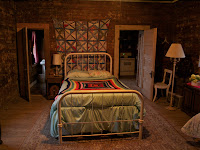The
ghost tours at the Crescent Hotel start off fun. After all, it’s a gorgeous
Victorian hotel at the top of a mountain overlooking Eureka Springs and a
member of the Historic Hotels of America so I’m imagining I will hear tales of
ethereal men in top hats and ladies playing croquet.
We
began on the third floor and indeed heard tales of these Victorian visitors who
have refused to check out. But as we slowly descended, the stories got creepier
and creepier. Then we ended up in the morgue!
 |
| The Crescent Hotel "Morgue." |
Yeah,
you heard right.
“Our
morgue is one of those historic infamies that has made us famous in the world
of the paranormal and those interested in that world,” said Bill Ott, the
hotel’s director of marketing and communications. “It wasn’t part of the
original business plan of the Eureka Springs Improvement Company who built this
mountaintop spa resort more than 125 years ago, it just turned out that way.”
The
hotel began in 1886 as a retreat for the upper class — but mostly for the summer
months. The rest of the year, from 1908 to 1934, the building was as The
Crescent College & Conservatory for Young Women. The depression caused the
college and the hotel to close its doors but Norman Baker, “the man from
Muscatine” reopened them in 1937, this time as a hospital to cure cancer.
The
Baker Cancer Curing Hospital promised a cure Baker couldn’t deliver — and he
made a fortune in the process. The building’s basement housed a morgue for
patients who perished onsite.
 |
| The 'Ghost Hunters' locker |
“It
is the sad years and sad tales of the Baker Hospital that are the genesis of
the Crescent Hotel’s morgue,” Ott explained. “It was in the morgue where Baker
used his large walk-in cooler to store cadavers and body parts, and his autopsy
table more for studying the cancers removed from patients in an effort to
discover ‘what went wrong’ when a patient died hoping to stumble upon a cure. Both
of these gruesome artifacts remain intact as do the stories — and some would
say the patients — that surround them.”
Baker
was arrested for mail fraud in 1939 and convicted a year later. The building
was resurrected as a hotel in 1997 and with it the tales of paranormal
activity. Lots of them, from the Irish man who fell to his death while
constructing the building to the college coed who jumped — or was pushed
— from a balcony.
And
then there are the ones in the morgue.
Ghost
tours began, concluding each night at the now famous morgue. It was in the
morgue that TV’s “Ghost Hunters” saw a full-body apparition on their thermal
imaging camera, something they called “the holy grail of ghost hunting.”
“The
ghost tours, which have grown exponentially over the past 16 years thanks to
exposure on national television programs and in national publications, have
always included the morgue,” said Jack Moyer, hotel’s general manager since
1997, “but until recently that space has had a dual purpose: maintenance area
by day, eerie morgue by night. But now, maintenance has been removed and the
morgue readied for thrilling new discoveries by curious ghost tour patrons.”
Throughout
October, the 1886 Crescent Hotel and Spa will reopen its morgue and allow
visitors to view items such as a wheelchair from the Baker Hospital, medical
artifacts from that era, the addition of a micro-theatre and easier access to
the walk-in cooler, autopsy table and the locker made famous by “Ghost Hunters.”
For
more information regarding the morgue and other paranormal facts surrounding
the 1886 Crescent Hotel & Spa, visit
americasmosthauntedhotel.com.
 We’re
found a Bilbo Street in Lake Charles, in Louisiana’s southwest corner. Even
more shocking — but perhaps appropo — is the Bilbo Baggins Pub in Bossier City,
just east of Shreveport.
We’re
found a Bilbo Street in Lake Charles, in Louisiana’s southwest corner. Even
more shocking — but perhaps appropo — is the Bilbo Baggins Pub in Bossier City,
just east of Shreveport.







































